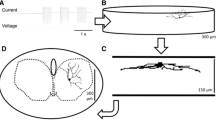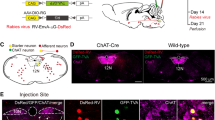Abstract
Somatic motor neurons in the hypoglossal nucleus innervate tongue muscles controlling vital functions such as chewing, swallowing and respiration. Formation of functional hypoglossal nerve circuits depends on the establishment of precise hypoglossal motor neuron maps correlating with specific tongue muscle innervations. Little is known about the molecular mechanisms controlling mammalian hypoglossal motor neuron topographic map formation. Here we show that combinatorial expression of transcription factors Runx1, SCIP and FoxP1 defines separate mouse hypoglossal motor neuron groups with different topological, neurotransmitter and calcium-buffering phenotypes. Runx1 and SCIP are coexpressed in ventromedial hypoglossal motor neurons involved in control of tongue protrusion whereas FoxP1 is expressed in dorsomedial motor neurons associated with tongue retraction. Establishment of separate hypoglossal motor neuron maps depends in part on Runx1-mediated suppression of ventrolateral and dorsomedial motor neuron phenotypes and regulation of FoxP1 expression pattern. These findings suggest that combinatorial actions of Runx1, SCIP and FoxP1 are important for mouse hypoglossal nucleus somatotopic map formation.









Similar content being viewed by others
Abbreviations
- 10N:
-
Dorsal motor nucleus of vagus
- 12N:
-
Hypoglossal nucleus
- βGal:
-
Beta galactosidase
- CGRP:
-
Calcitonin gene related peptide
- ENCODE:
-
Encyclopedia of DNA Elements
- HBS:
-
HEPES-buffered saline
- MN:
-
Motor neuron
- PBS:
-
Phosphate-buffered saline
- PNS:
-
Peripheral nervous system
- PV:
-
Parvalbumin
- XGal:
-
5-Bromo-4-chloro-3-indolyl-β-galactopyranoside
References
Aldes LD (1995) Subcompartmental organization of the ventral (protrusor) compartment in the hypoglossal nucleus of the rat. J Comp Neurol 353:89–108
Altschuler SM, Bao X, Miselis RR (1994) Dendritic architecture of hypoglossal motor neurons projecting to extrinsic tongue musculature in the rat. J Comp Neurol 342:538–550
Arber S, Han B, Mendelsohn M, Smith M, Jessell TM, Sockanathan S (1999) Requirement for the homeobox gene HB9 in the consolidation of motor neuron identity. Neuron 23:659–674
Bruno L, Mazzarella L, Hoogenkamp M, Hertweck A, Cobb BS, Sauer S et al (2009) Runx proteins regulate Foxp3 expression. J Exp Med 206:2329–2337
Chang IY, Kim SW, Lee KJ, Yoon SP (2008) Calbindin D-28 k, parvalbumin and calcitonin gene-related peptide immunoreactivity in the canine spinal cord. Anat Histol Embryol 37:446–451
Chen CL, Broom DC, Liu Y, de Nooij JC, Li Z, Cen C et al (2006) Runx1 determines nociceptive sensory neuron phenotype and is required for thermal and neuropathic pain. Neuron 49:365–377
Chibuzo GA, Cummings JF (1982) An enzyme tracer study of the organization of the somatic motor center for the innervation of different muscles of the tongue: evidence for two sources. J Comp Neurol 205:273–281
Dasen JS, Tice BC, Brenner-Morton S, Jessell TM (2005) A Hox regulatory network establishes motor neuron pool identity and target-muscle connectivity. Cell 123:477–491
Dasen JS, De Camilli A, Wang B, Tucker PW, Jessell TM (2008) Hox repertoires for motor neuron diversity and connectivity gated by a single accessory factor, FoxP1. Cell 134:304–316
de Souza E, Coveñas R, Yi P, Aguilar LA, Lerma L, Andrade R et al (2008) Mapping of CGRP in the alpaca (Lama pacos) brainstem. J Chem Neuroanat 35:346–355
Dunham I, Kundaje A, Aldred SF, Collins PJ, Davis CA, Doyle F et al (2012) An integrated encyclopedia of DNA elements in the human genome. Nature 489:57–74
Francius C, Clotman F (2014) Generating spinal motor neuron diversity: a long quest for neuronal identity. Cell Mol Life Sci 71:813–829
Kanning KC, Kaplan A, Henderson CE (2010) Motor neuron diversity in development and disease. Annu Rev Neurosci 33:409–440
Kitoh A, Ono M, Naoe Y, Ohkura N, Yamaguchi T, Yaguchi H et al (2009) Indispensable role of the Runx1-Cbfbeta transcription complex for in vivo-suppressive function of FoxP3 + regulatory T cells. Immunity 31:609–620
Kramer I, Sigrist M, de Nooij JC, Taniuchi I, Jessell TM, Arber S (2006) A role for Runx1 transcription factor signaling in dorsal root ganglion sensory neuron diversification. Neuron 49:379–393
Krammer EB, Rath T, Lischka MF (1979) Somatotopic organization of the hypoglossal nucleus: a HRP study in the rat. Brain Res 170:533–537
Levanon D, Bettoun D, Harris-Cerruti C, Woolf E, Negreanu V, Eilam R et al (2002) The Runx3 transcription factor regulates development and survival of TrkC dorsal root ganglia neurons. EMBO J 21:3454–3463
Lewis PR, Flumerfelt BA, Shute CCD (1971) The use of cholinesterase techniques to study topographical localization in the hypoglossal nucleus of the rat. J Anat (London) 110:203–213
Lowe AA (1981) The neural regulation of tongue movements. Prog Neurol 15:295–344
Lowe AA (1984) Tongue movements-brainstem mechanisms and clinical postulates. Brain Behav Evol 25:128–137
Machado CB, Kanning KC, Kreis P, Stevenson D, Crossley M, Nowak M et al (2014) Reconstruction of phrenic neuron identity in embryonic stem cell-derived motor neurons. Development 141:784–794
McClung JR, Goldberg SJ (1999) Organization of motoneurons in the dorsal hypoglossal nucleus that innervate the retrusor muscles of the tongue in the rat. Anat Rec 254:222–230
McClung JR, Goldberg SJ (2000) Functional anatomy of the hypoglossal innervated muscles of the rat tongue: a model for elongation and protrusion of the mammalian tongue. Anat Rec 260:378–386
Murthy M, Bocking S, Verginelli F, Stifani S (2014) Transcription factor Runx1 inhibits proliferation and promotes developmental maturation in a selected population of inner olfactory nerve layer olfactory ensheathing cells. Gene 540:191–200
North T, Gu TL, Stacy T, Wang Q, Howard L, Binder M et al (1999) Cbfa2 is required for the formation of intra-aortic hematopoietic clusters. Development 126:2563–2575
Odutola AB (1976) Cell grouping and Golgi architecture of the hypoglossal nucleus in the rat. Exp Neurol 52:356–371
Palmesino E, Rousso DL, Kao T-J, Klar A, Laufer E, Uemura O et al (2010) Foxp1 and Lhx1 Coordinate Motor Neuron Migration with Axon Trajectory Choice by Gating Reelin Signalling. PLoS Biol 8(8):e1000446
Philippidou P, Walsh CM, Aubin J, Jeannotte L, Dasen JS (2012) Sustained Hox5 gene activity is required for respiratory motor neuron development. Nature Neurosci 15:1636–1644
Rousso DL, Gaber ZB, Wellik D, Morrisey EE, Novitch BG (2008) Coordinated actions of the forkhead protein Foxp1 and Hox proteins in the columnar organization of spinal motor neurons. Neuron 59:226–240
Rudra D, Egawa T, Chong MM, Treuting P, Littman DR, Rudensky AY (2009) Runx-CBFbeta complexes control expression of the transcription factor Foxp3 in regulatory T cells. Nat Immunol 10:1170–1177
Sienkiewicz W, Dudek A, Kaleczyc J, Chrószcz A (2010) Immunohistochemical characterization of neurones in the hypoglossal nucleus of the pig. Anat Histol Embryol 39:152–159
Smith JC, Goldberg SJ, Shall MS (2005) Phenotype and contractile properties of mammalian tongue muscles innervated by the hypoglossal nerve. Respir Physiol Neurobiol 147:253–262
Stifani N, Freitas AR, Liakhovitskaia A, Medvinsky A, Kania A, Stifani S (2008) Suppression of interneuron programs and maintenance of selected spinal motor neuron fates by the transcription factor AML1/Runx1. Proc Natl Acad Sci USA 105:6451–6456
Sürmeli G, Akay T, Ippolito GC, Tucker PW, Jessell TM (2011) Patterns of spinal sensory-motor connectivity prescribed by a dorsoventral positional template. Cell 147:653–665
Theriault FM, Roy P, Stifani S (2004) AML1/RUNX1 is important for the development of hindbrain cholinergic branchiovisceral motor neurons and selected cranial sensory neurons. Proc Natl Acad Sci USA 101:10343–10348
Theriault FM, Nuthall HN, Dong Z, Lo R, Barnabe-Heider F, Miller FD et al (2005) Role for Runx1 in the proliferation and neuronal differentiation of selected progenitor cells in the mammalian nervous system. J Neurosci 25:2050–2061
Uemura-Sumi M, Mizuno N, Nomura S, Iwahori N, Takeuchi Y, Matshushima R (1981) Topographical representation of the hypoglossal nerve branches in the hypoglossal nucleus of the Macaque monkeys. Neurosci Lett 22:31–35
Yang X, Arber S, William C, Li L, Tanabe Y, Jessell TM et al (2001) Patterning of muscle acetylcholine receptor gene expression in the absence of motor innervation. Neuron 30:399–410
Yoshikawa M, Hirabayashi M, Ito R, Ozaki S, Aizawa S, Masuda T et al (2015) Contribution of the Runx1 transcription factor to axonal pathfinding and muscle innervation by hypoglossal motoneurons. Dev Neurobiol 75:1295−1314
Zagami CJ, Stifani S (2010) Molecular characterization of the mouse superior lateral parabrachial nucleus through expression of the transcription factor Runx1. PLoS One 5(11):e13944
Zhao H, Zhou W, Yao Z, Wan Y, Cao J, Zhang L et al (2015) Foxp1/2/4 regulate endochondral ossification as a suppressor complex. Dev Biol 398:242–252
Zhuang S, Zhang Q, Zhuang T, Evans SM, Liang X, Sun Y (2013) Expression of Isl1 during mouse development. Gene Expr Patterns 13:407–412
Zusso M, Methot L, Lo R, Grenhalgh AD, David S, Stifani S (2012) Regulation of postnatal forebrain amoeboid microglial cell proliferation and development by the transcription factor Runx1. J Neurosci 32:11285–11298
Acknowledgments
We thank Dr. Silvia Arber for Tau Runx1 mice, Dr. Artur Kania for Hb9 Cre mice, Dr. Jeremy Dasen for anti-SCIP antibodies, and Dr. Jean-Francois Cloutier for microscopy support. We also thank Ye Man Tang and Rita Lo for excellent technical assistance, and Mireille Bouchard-Levasseur and Stephanie Perrino for invaluable help with animal care. X.C. was supported by the National Natural Science Foundation of China (81370029) and the Project of Tianjin Applied Basic and Cutting-edge Technological Research (13JCQNJC10500). A.S.C. was supported by Postdoctoral Fellowship from the Fonds de la Recherche du Québec-Santé. R.D. was supported by CIHR-Vanier Canada Graduate Scholarship. This work was supported by Grants from the Canadian Institutes of Health Research (MOP-123500) and ALS Canada (Bridge Funding) to S.S. who is a James McGill Professor of McGill University.
Author information
Authors and Affiliations
Corresponding author
Ethics declarations
Conflict of interest
The authors declare that they have no conflict of interest.
Additional information
X. Chen and J. W. Wang contributed equally.
Electronic supplementary material
Below is the link to the electronic supplementary material.
Rights and permissions
About this article
Cite this article
Chen, X., Wang, J.W., Salin-Cantegrel, A. et al. Transcriptional regulation of mouse hypoglossal motor neuron somatotopic map formation. Brain Struct Funct 221, 4187–4202 (2016). https://doi.org/10.1007/s00429-015-1160-2
Received:
Accepted:
Published:
Issue Date:
DOI: https://doi.org/10.1007/s00429-015-1160-2




